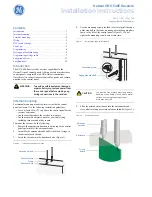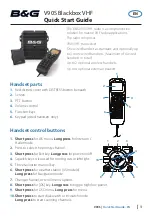
NetworX NX-548E Receiver
Installation Instructions
4
Programming
This section describes how to program the units.
Programming guidelines
Use the following programming guidelines:
• NX-4 and NX-6 control panels can have receivers added
with zones that overlap those contained in the control panel.
No hardware expanders can be used.
• NX-8 control panels can have expansion zones (hardwire or
wireless) set the same as those contained in the control
panel. To do this you must disable the onboard control panel
zones in panel location 37. All zone expansion modules
must not overlap any blocks of 8 zones.
• All other control panels can have wireless zones added to
any zone. If a hardwire input (on either the control panel or
hardwire expander) is also present on the same zone as an
enabled wireless zone, the wireless transmitter takes
priority.
Transmitter programming
When programming wireless transmitters into the receiver, you
can set various options and partitions for each transmitter. These
settings appear in segments of each programming location.
Use
Table 5
on page 7 to record zone assignments and settings.
Be sure to circle where each zone resides:
RM.
Receiver module
HE.
Hardwire expander
P.
Panel
This gives you all the programming information in one place to
facilitate the programming process.
Zone locations 1 to 192
Zone locations 1 to 192 are not numbered in
Table 5
on page 7
since these locations vary depending on location 194,
Receiver
zone bank setting.
Note:
The default settings shown for segments 1 and 2 in the first
zone location apply to all zone locations.
Add transmitters
LCD touchpads will display instructions when accomplishing tasks.
To add transmitters, do the following:
1.
Enter
* 8
at the keypad. On LED touchpads, the five func-
tion lights start flashing.
2.
Enter the
program code
(factory default is
9 7 1 3
). On LED
touchpads, the service light flashes and the five function
lights change from flashing to on steady.
3.
Enter the DIP switch setting module number and press
#
.
On LED touchpads, the Armed LED turns on, indicating the
control panel is waiting for a programming location entry.
4.
For new installations, enter
9 1 0 #
to load factory defaults
and clear any unwanted information in memory.
5.
For new installations, set the receiver zone bank setting in
location 194 to determine the starting zone number for the
specific receiver. This applies only to NX-8E.
This must be
set before learning sensors
. For example, if location 194 is
set to 3, the first available location is 25. The total number
of available locations depends on the zone limits for both
the panel and receiver.
6.
Enter
0 #
to enter the sensor learning location. On LED
touchpads, the Ready LED turns on and the Armed LED
turns off.
7.
Enter the zone number (1 through 192) and press
*
. Three
beeps from the keypad indicate an entry error. This occurs if
you enter a transmitter number that is not within the
receiver’s zone block or if the location already has a sensor
learned into it.
Note:
If you change your mind about your entry, terminate
programming by entering
0 # 0 *
and start over at
step 6.
8.
Trip the desired transmitter (within 250 seconds) as
described in
Table 4
. Listen for the
ding dong
for confirma-
tion
.
Note:
For specific instructions on tripping a transmitter,
consult the transmitter’s manual.
9.
To program remaining transmitters, repeat steps 6 to 8.
10. To exit program mode, press
EXIT EXIT
.
11. Confirm that the
zone types and partition assignments are
set correctly in the control panel. Refer to the control panel
installation manual for instructions on how to set zone types
and partition assignments.
Note:
When an 80-bit device is added, Feature 6 of Segment 1
(see
Table 5
on page 7) is turned on. But when a 63-bit
device is added on a zone location that previously had an
80-bit device, make sure to turn off Feature 6 of Segment 1.
Table 4.
Tripping transmitters
Transmitter
Action
Door/window, shock, glass
guard, freeze, UFT (Universal
Fire Transmitter)
Activate tamper switch by removing cover.
Door/window with external
contact
Activate tamper switch by removing cover.
Feature 4—Input option 1, must be on.
Recessed door/window
Activate tamper switch by removing circuit
board until tamper switch is exposed.
Micro door/window and
Micro recessed door/window
Refer to the installation instructions for the
specific sensor for activation information.
SlimLine door/window
Remove cover, then press the button on
the top of the sensor, or activate the
tamper switch by removing the cover.
PIR
Activate tamper switch by removing back
plate from PIR.
Smoke detector without
tamper switch
Press and hold the test button.
Smoke detector with tamper
switch
Trip the tamper switch.
Feature 4—Input
option 1, must be on.
Heat detector
Press, then release the tamper switch.
Single button panic
Press and hold the button.
Dual button panic
Press and hold both buttons together.
Keyfobs
Press and hold the lock and unlock buttons
together.
Repeater
Press, then release the tamper switch.






























